-
Weekly weather: Cold waves are here! There is a risk of heavy snow and blizzard on the Sea of Japan side during the three-day holiday period.
2026/01/07 08:22
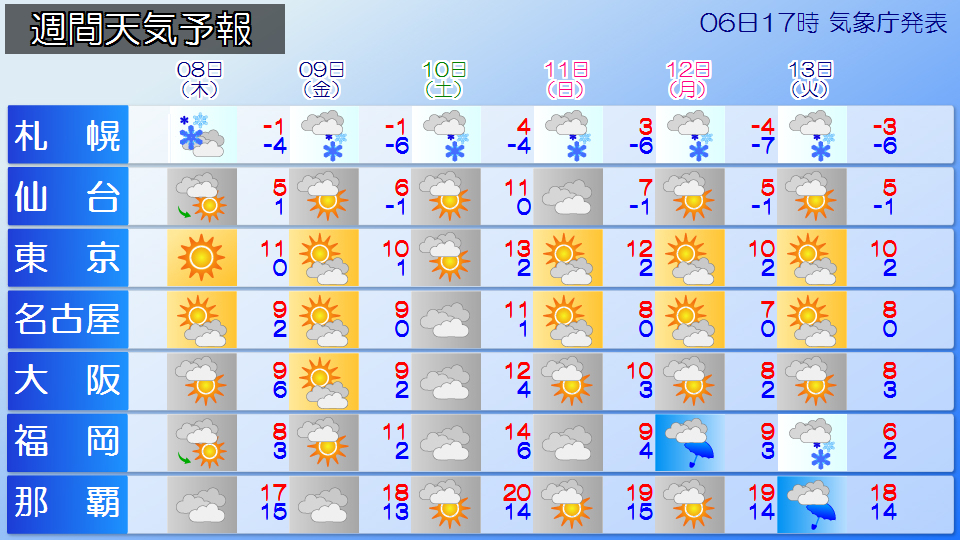
-
From now on, the winter-like atmospheric pressure pattern will become stronger around Honshu, and strong cold air will move southward. During the three-day holiday period, there will be heavy snow on the Sea of Japan side. The effects of the cold air are expected to linger long after the three-day weekend ends.
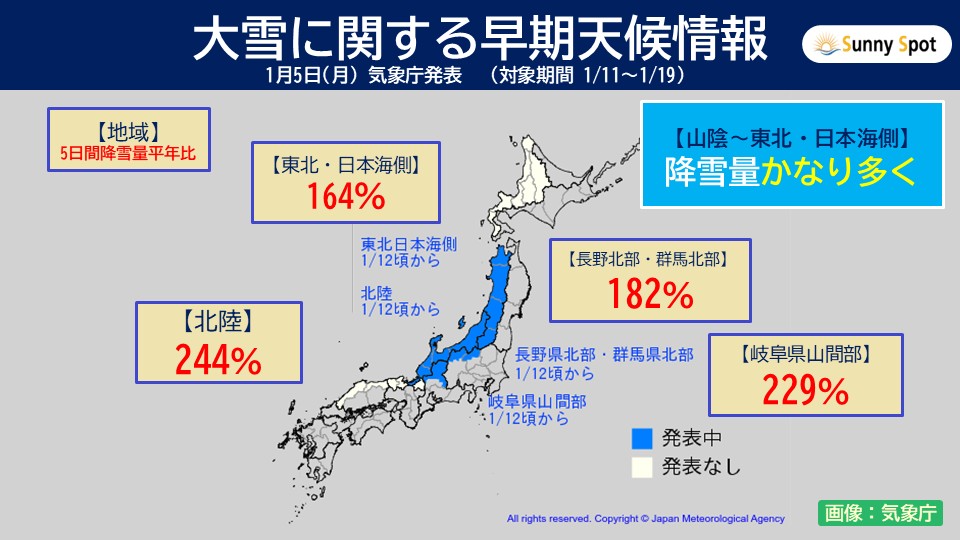
On the 5th of last year, the Japan Meteorological Agency announced "early weather information regarding heavy snow." This information is being announced at a time when the possibility of significant snowfall on a ``once-in-a-decade'' level is higher than usual. From the Sea of Japan side of Tohoku to the Hokuriku region, the amount of snowfall over the five days is expected to be approximately 1.5 to 2.5 times the normal level, which is expected to be a significant amount.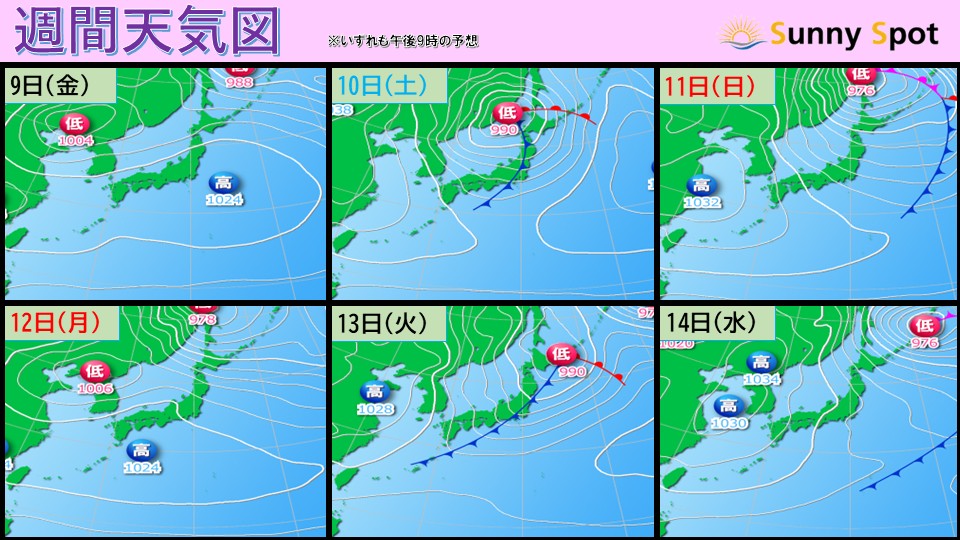
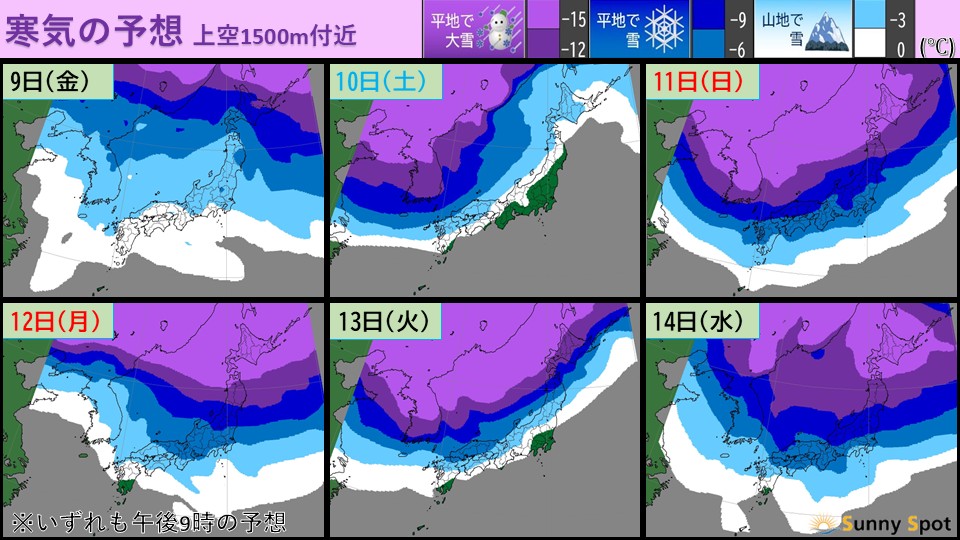
A low pressure system will pass through the Sea of Japan around the 10th (Saturday), the first day of the three-day holiday. The low pressure system is expected to rapidly develop and move toward Sakhalin until the 11th (Sunday), and a winter-like pressure pattern is expected to strengthen around Honshu.
For this reason, from around the 11th of the three-day weekend, heavy snow will be expected on the Sea of Japan side from Tohoku to Hokuriku, and heavy snow will also be felt along the mountains in the northern Kanto region, the Koshin region, and in the mountainous areas of Gifu Prefecture in the Tokai region. It is expected to snow in the Sanin region starting around the 11th. In areas along the Sea of Japan, there is a risk of strong winds and a blizzard.
The strong cold air in the sky is expected to remain over Honshu for a long time after the three-day weekend. Around the 13th, the low pressure system is expected to pass through the Sea of Japan again, and around the 14th, the winter-like pressure pattern is expected to become stronger again. As a result, it is expected that after the 13th, there will be widespread snow from northern Japan to western Japan on the Sea of Japan side, and the snowfall will further increase.
If you have plans during the three-day weekend or are going to the Coming of Age Day event on the 12th, please be aware of the impact on transportation and be sure to check the latest information. Be careful of traffic disruptions caused by heavy snow and poor visibility caused by blizzards, and be aware of avalanches in the Sanin area, where a strong earthquake occurred.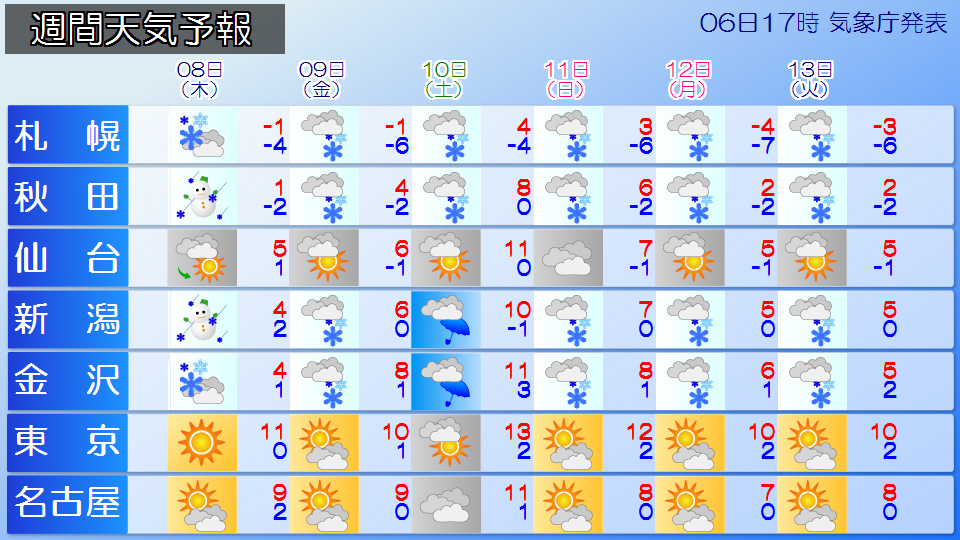
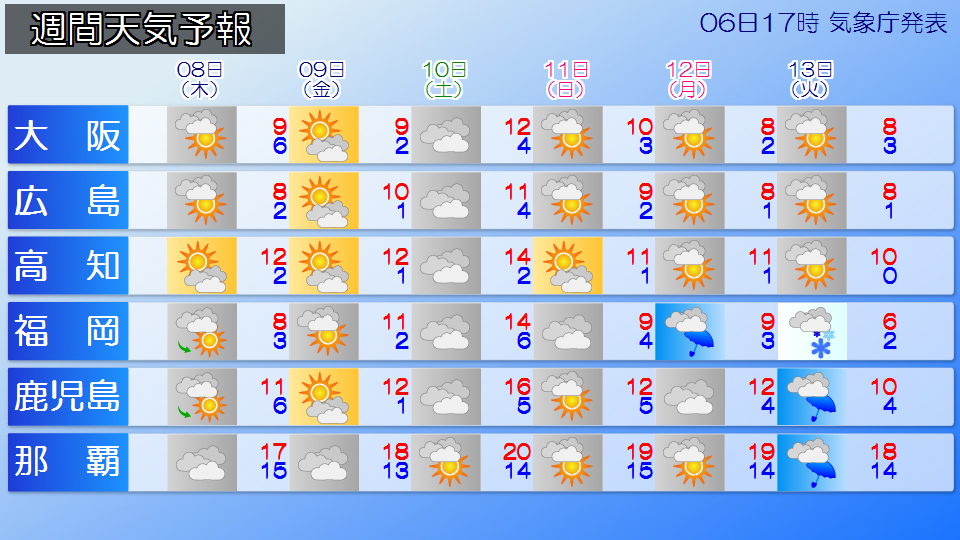
-
Tomorrow, the 7th (Wednesday), the weather will be downhill on the Sea of ??Japan side.The next day, the 8th (Thursday), the winter-like atmospheric pressure pattern will strengthen, and there is a risk of heavy snow on the Japan Sea side.
2026/01/06 21:57
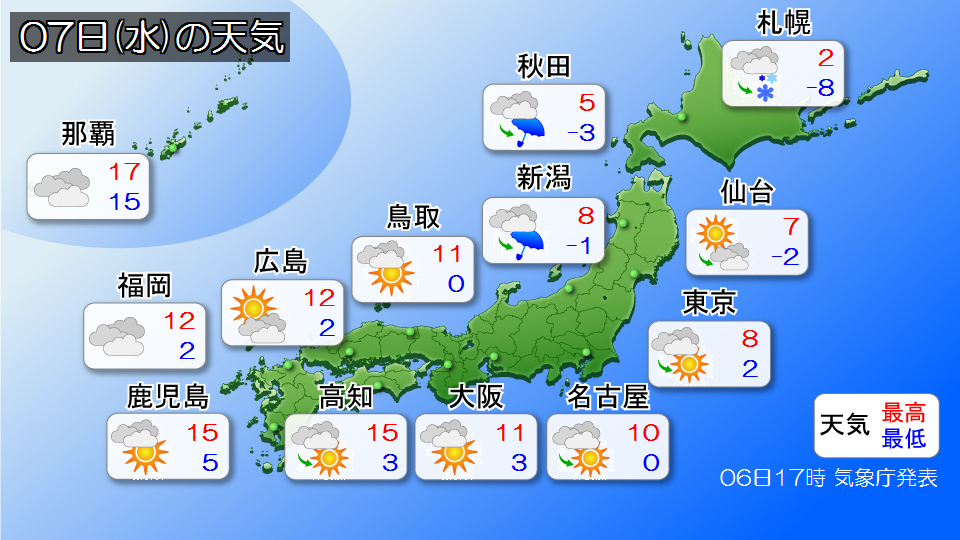
-
Tomorrow, the 7th (Wednesday), three low pressure systems will move near Honshu. In the morning, there will be rain and snow in parts of western Japan and the Pacific side of eastern Japan, and in the afternoon the weather will turn downward from the Sea of Japan side of northern Japan to Hokuriku.
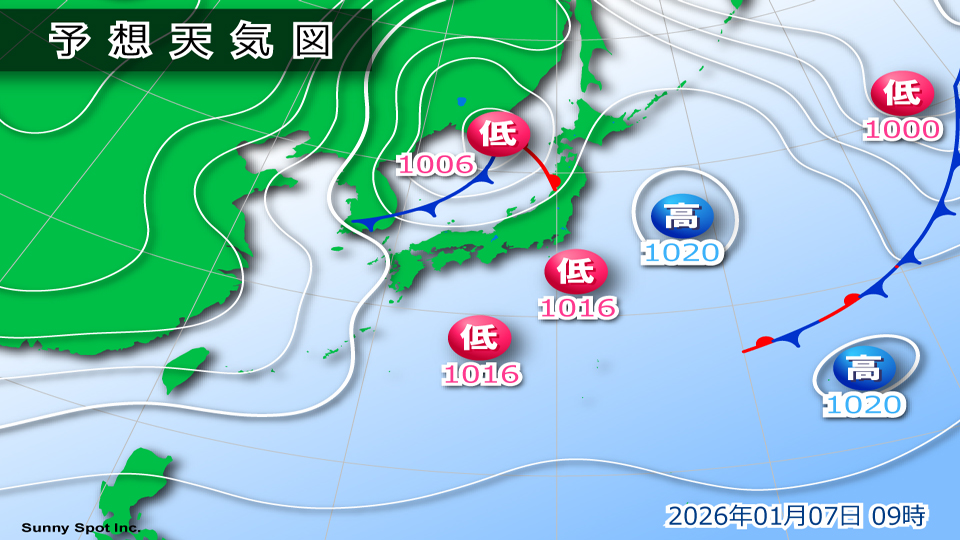
Tomorrow, the 7th, in southern Kyushu and Okinawa, rain clouds will approach from the west, so there will be some places where it will rain mainly in the morning. Please be careful of lightning as it will be accompanied by local lightning.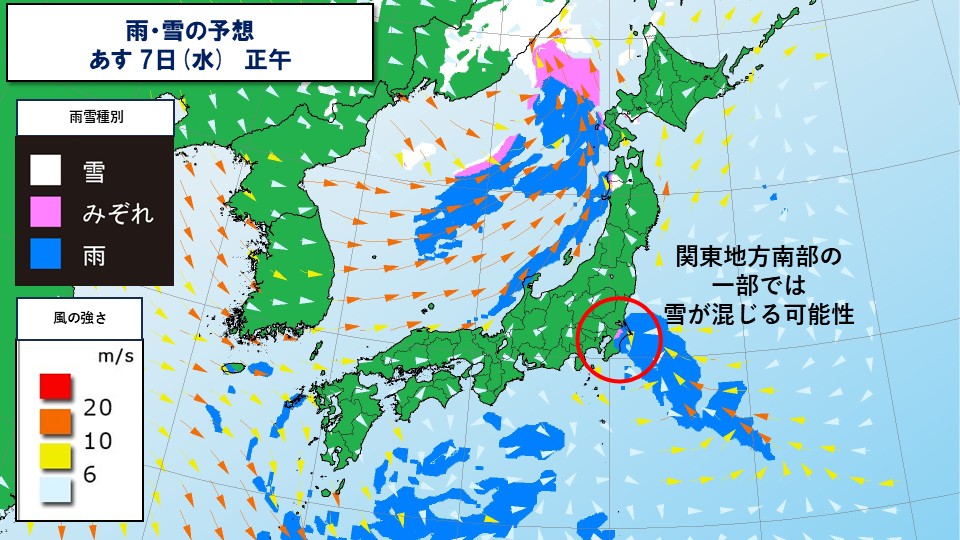
Some areas of the Kanto region will be affected by the low pressure that will form near the Izu Islands by morning. From noon to early afternoon, rain is expected to occur along the coast, with some snow mixed in in some places. The period of rain and snow will be short as the low pressure system will gradually move out to the east over the ocean. However, the air is cold, and daytime temperatures are expected to reach 10 degrees Celsius in many places. Be sure to take precautions against the cold.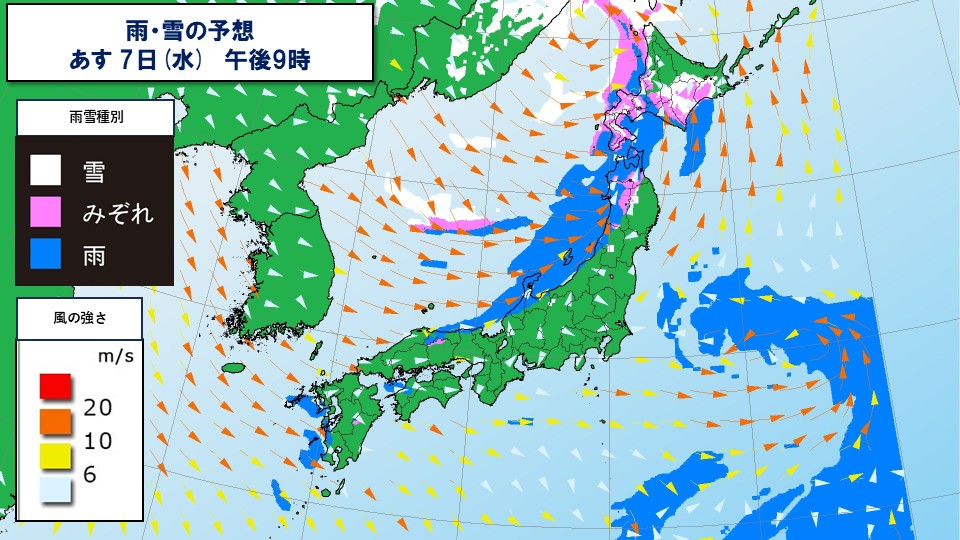
From the Sea of Japan side of northern Japan to the Hokuriku region, it will gradually become rainy and snowy due to the influence of low pressure and fronts moving through the Sea of Japan. Due to the warm air, it is expected to rain in many places in Hokuriku and the Sea of Japan side of northeastern Japan, and in Hokkaido, it will be rain and wet snow, and the wind will become stronger through the night, causing blizzard in some places. In areas with heavy snowfall, be careful of deteriorating road conditions. Even in Tottori and Shimane prefectures, which experienced strong shaking on the 6th, there are likely to be some places where it will rain or snow in the evening.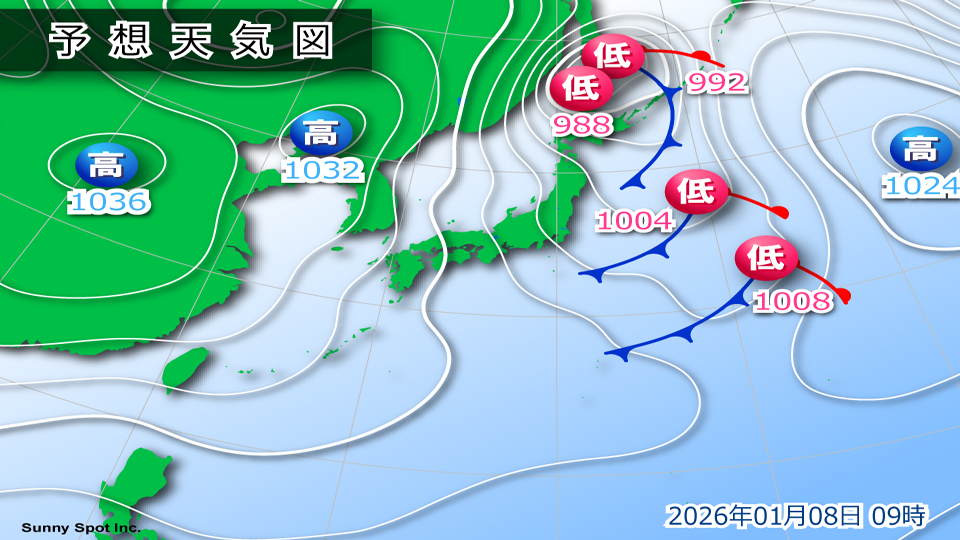
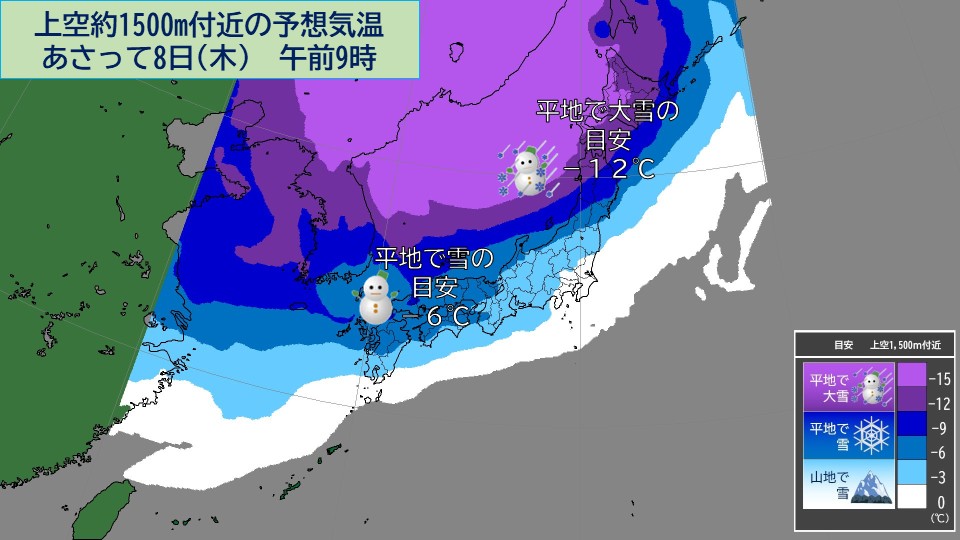
The 8th tomorrow (Thursday), the winter-like atmospheric pressure pattern is expected to strengthen near Honshu, and strong cold air with temperatures below -6 C at an altitude of approximately 1,500 meters is expected to move southward to near Shikoku. The spacing between the isobar lines is narrow vertically, and there is a risk of heavy snow and strong winds from the Sea of Japan side of northern Japan to the Hokuriku region, resulting in a blizzard. Be careful of traffic disruptions caused by heavy snow and poor visibility caused by blizzards, and be wary of high waves in coastal areas. There will be places in the northern Kinki region and the Sanin area where it will snow and rain.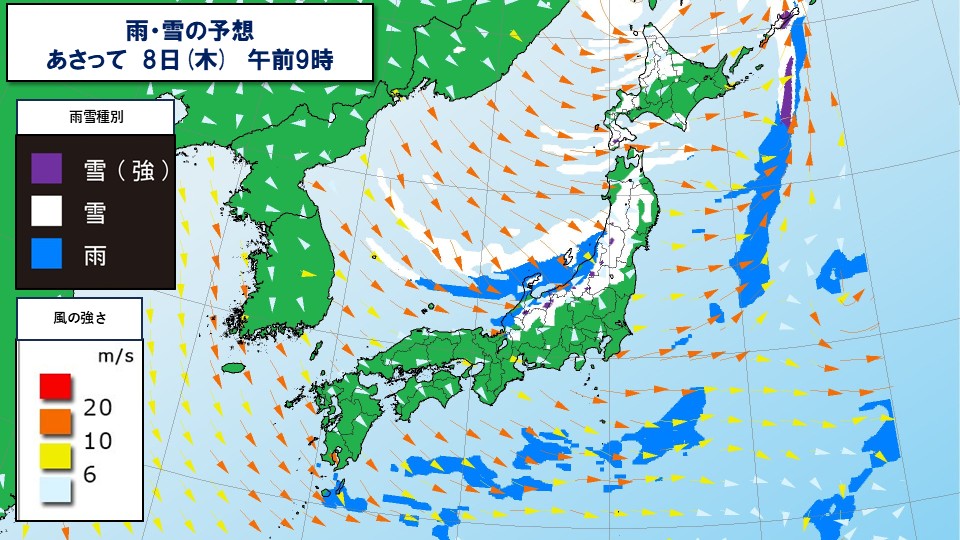
There is a high risk of rockfalls and landslides near Tottori and Shimane prefectures, which experienced strong shaking. In areas with heavy snowfall, be careful of avalanches and falling snow.
-
It will snow widely in the Chugoku region the next day. Winter storm on the Honkai side during three consecutive holidays. Winter-like atmospheric pressure pattern will continue even after Coming of Age Day [Weekly Weather Forecast]
2026/01/06 12:53
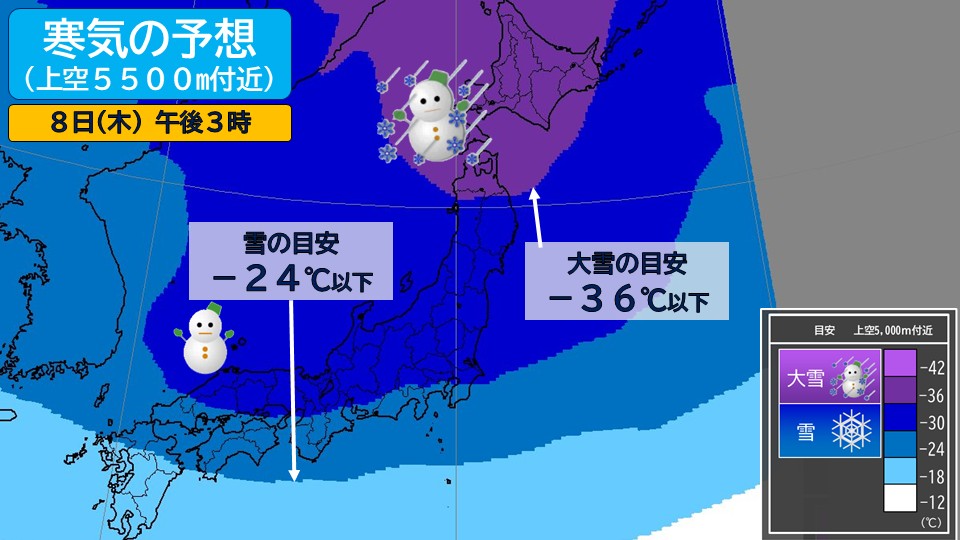
-
Weekly Weather Forecast
#Winter-like atmospheric pressure pattern is increasing frequently; snow will spread across the Chugoku region tomorrow
#3-day holiday Winter storm on the Sea of Japan side Winter-type pressure pattern will continue even after Coming of Age Day
#Cold weather continues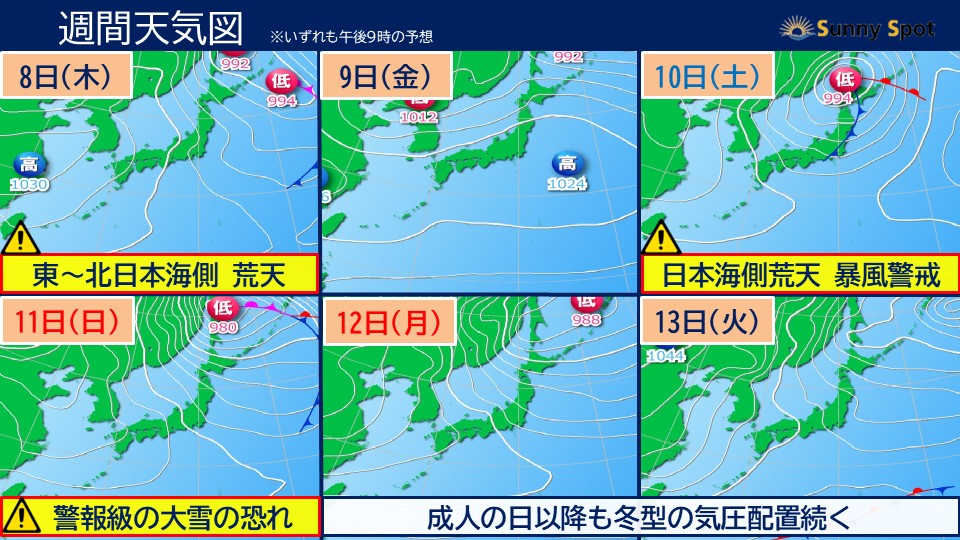
#Winter-like pressure patterns are expected to strengthen frequently The day after, it will snow widely in the Chugoku region
For the next week, it looks like it will be cold, and the winter-type pressure patterns will frequently become stronger, and cold air is expected to flow in with increasing strength.
Tomorrow, the 7th (Wednesday), a low pressure system with a front in the central Japan Sea is expected to rapidly develop and move toward the northern Japan Sea.
A front extending from a low pressure system will pass near Honshu, and there will be showers and snow showers on the Sea of Japan side of western Japan from the evening onwards.
In Hokuriku, it is expected to rain in coastal areas from around noon, and more places are expected to experience rain or snow at night.
There will be places in northern Japan where it will snow in the afternoon.
The following day, on the 8th (Thursday), a rapidly developing low pressure system will move toward the Sea of Okhotsk, and the front will pass near northern Japan, which is expected to bring about a winter-like pressure pattern around Japan once again.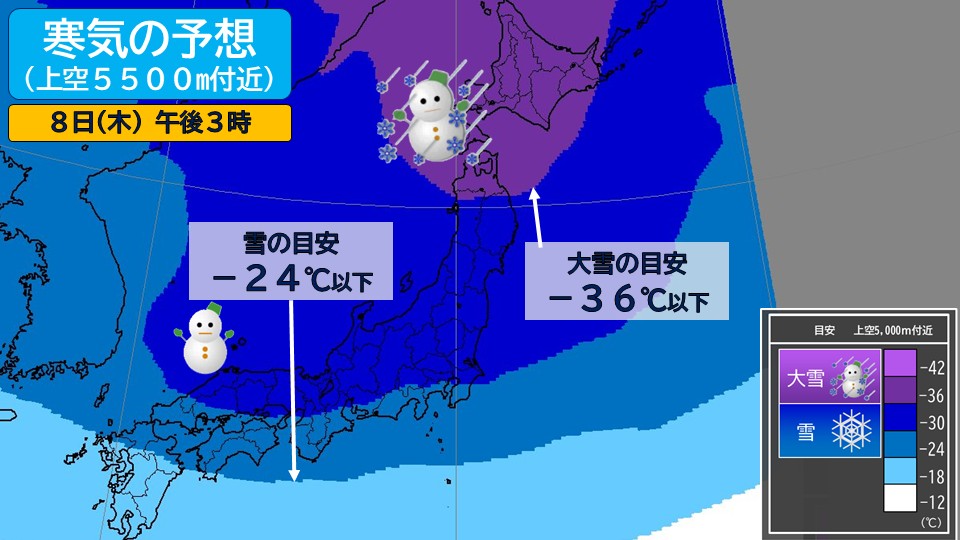
The winter-like pressure pattern will become stronger, and as strong cold air flows into the upper atmosphere, the area where snow will fall will expand on the Sea of Japan side.
Snow is expected to fall in parts of northern Kyushu, the Chugoku-Hokuriku Japan Sea side, and northern Japan.
Snow will continue to fall in Shimane and Tottori prefectures, where a seismic intensity of 5+ was observed today, the 6th (Tuesday).
It is expected to snow temporarily in northern Hiroshima and Okayama prefectures.
In eastern and northern Japan, there will be strong winds and rising waves, and in Hokkaido, there will be snowstorms and rough weather.
Although the winter-like pressure pattern will temporarily loosen on the 9th (Friday), the winter-like pressure pattern will strengthen again over the three-day weekend, making it likely to become a winter storm.
#3-day holiday winter storm on the Sea of Japan side Winter-type atmospheric pressure pattern will continue even after Coming of Age Day
On the first day of the 3-day holiday, from the 10th (Sat.) to the 11th (Sun.), a low pressure system is expected to develop as it passes from the Sea of Japan, near northern Japan, and toward the Sea of Okhotsk.
Strong cold air in the upper atmosphere will flow westward, and the winter-like pressure pattern will become stronger near Japan.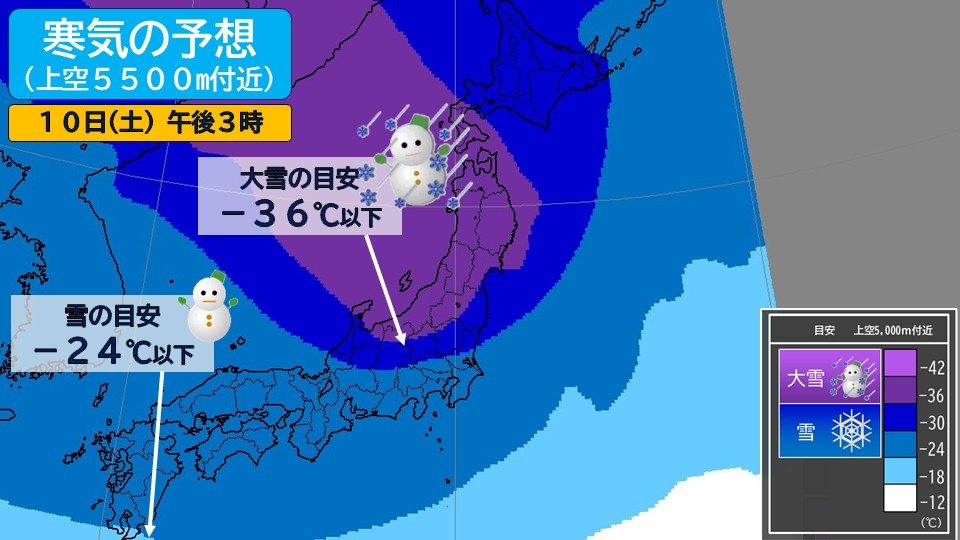
On the 10th (Saturday), rain and snow are expected to fall from the San'in area to the Sea of Japan side of the Hokuriku region, and there will be places where wet snow will fall along the mountains in the northern part of Gifu, Nagano, and Gunma prefectures.
It will snow intermittently in northern Japan.
On the 11th (Sunday), rain is expected to change to snow in more places in Shimane and Tottori prefectures, where seismic intensity levels of 5+ were observed.
There will be more snowfall in western and eastern Japan on the Sea of Japan side and in northern Japan, and there is a risk of heavy snowfall reaching warning level in northern Nagano Prefecture, northern Gunma Prefecture, and northern Japan on the Sea of Japan side.
From the 10th (Sat) to the 11th (Sun), there is a risk of warning-level snowstorms in the Sea of Japan side of western and eastern Japan and northern Japan, which will turn into a blizzard and become a winter storm.
Then, on the 12th (Monday) Coming of Age Day and the 13th (Tuesday), winter-like atmospheric pressure patterns will continue around Japan, and snow is expected to spread across the Sea of Japan side.
Please be aware of the latest information as transportation may be affected during the three-day holiday period.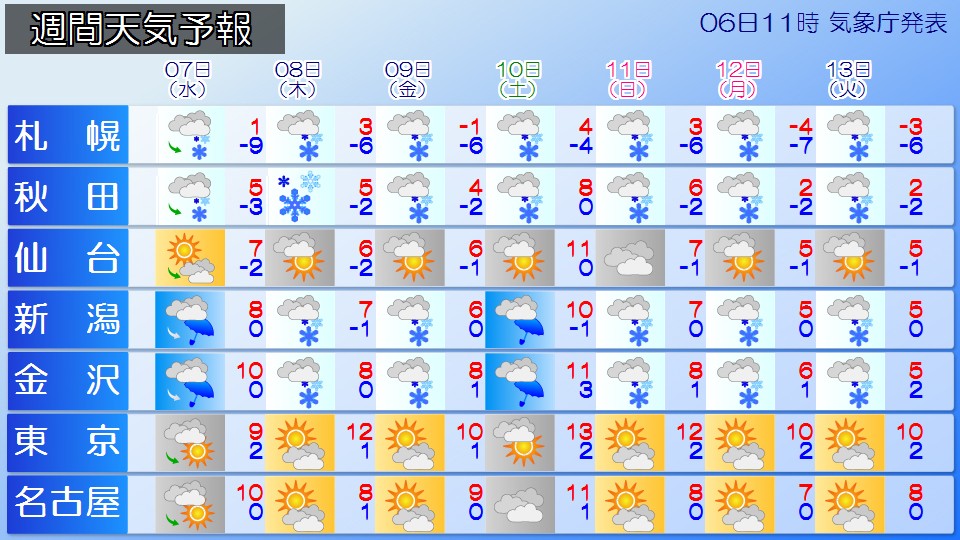
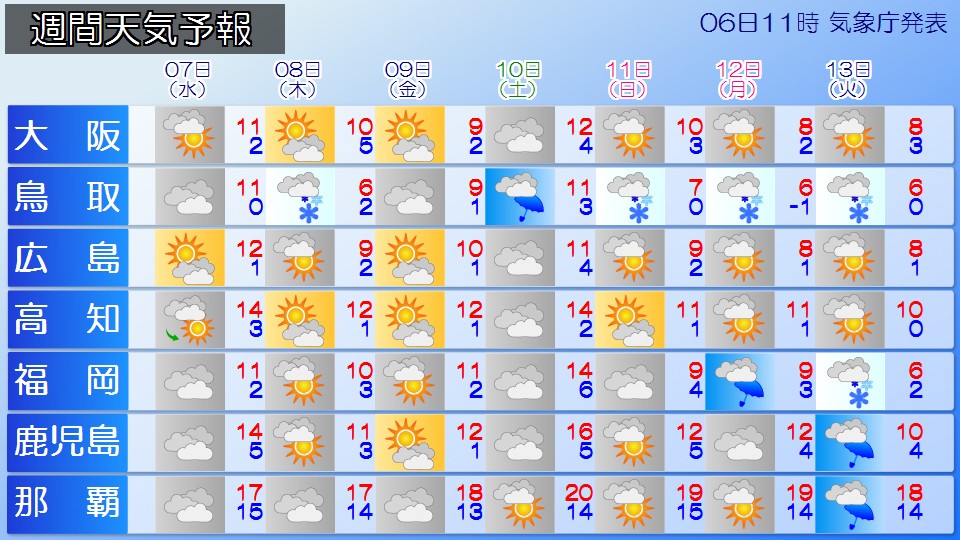
#The midwinter cold continues
As cold air repeatedly flows into Japan, it is expected that the midwinter cold will continue.
Please take care of your health.
-
Temperatures are lower nationwide than the previous day; severe cold in northern Japan
2026/01/06 07:56
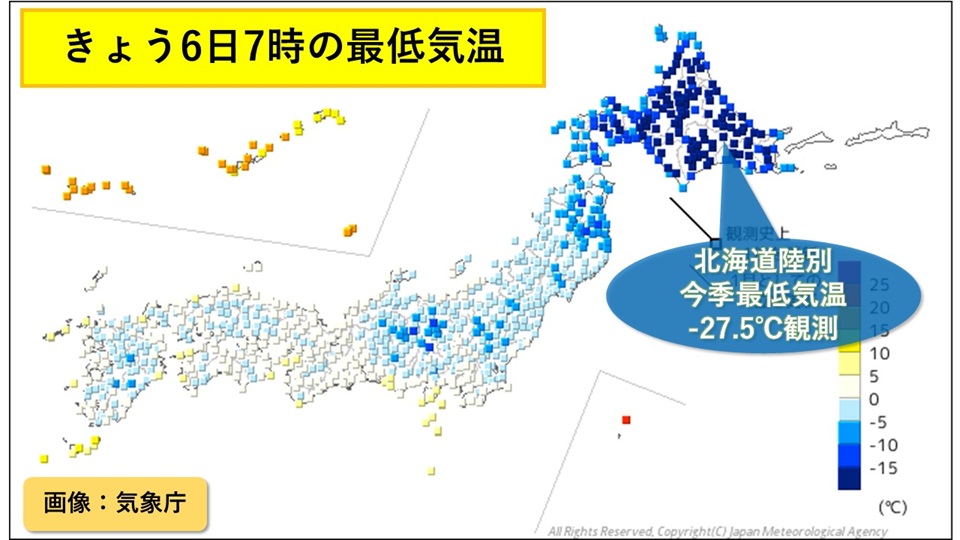
-
A winter-like atmospheric pressure pattern continues near Japan, and cold air in the upper atmosphere is moving southward. The weather is getting colder, especially in Hokkaido, and Rikubetsu in the Tokachi region of Hokkaido recorded -27.5 C, the lowest temperature in the country this season, at 7:01 am.
During the day, temperatures rose yesterday (the 5th) in eastern and western Japan, and are likely to drop in many places, and it looks like it will be winter-like cold for this time of year in many places.
Northern Japan will continue to experience severe cold weather, and Hokkaido is expected to be in the middle of winter for the entire prefecture.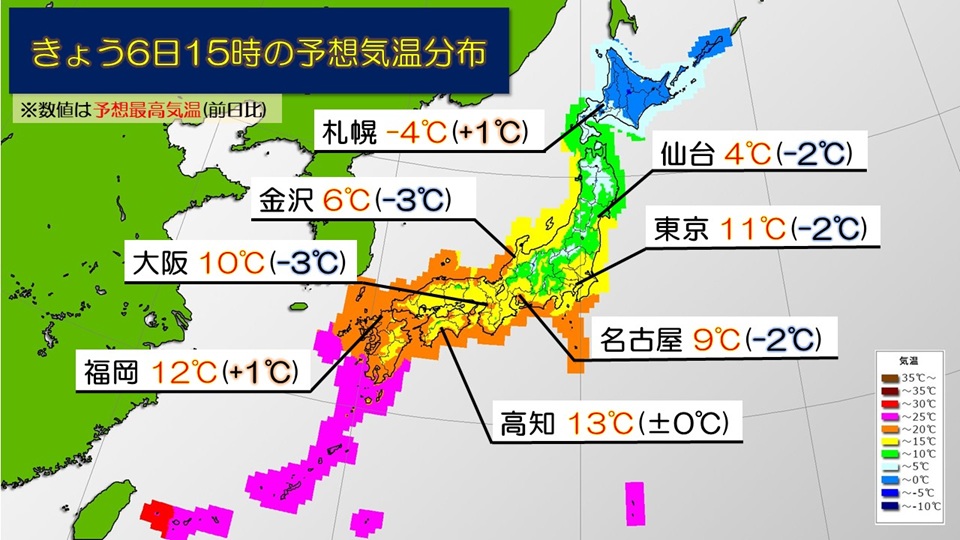
The predicted maximum temperature is -4c in Sapporo, 4c in Sendai, 11c in Tokyo, 9c in Nagoya, 6c in Kanazawa, 10c in Osaka, 13c in Kochi, and 12c in Fukuoka.
Even from eastern Japan to western Japan, there are likely to be places where it will be cold in the single digits during the day.
There will be a big difference in temperature from the previous day, so if you go out, please take proper measures to protect yourself from the cold and be careful not to get sick.
-
Today's weather on the 6th (Tuesday): Continued snow and rain on the Sea of ??Japan side; dry winter weather on the Pacific side
2026/01/06 06:20
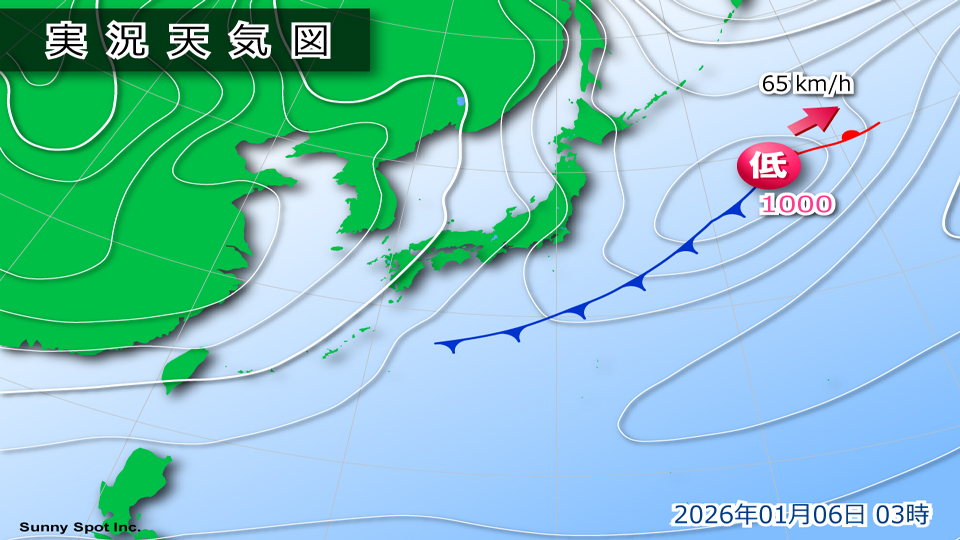
-
Today, the 6th (Tuesday), winter-like atmospheric pressure patterns will continue around Japan. It looks like it will be a day of heavy snow and rain on the Sea of Japan coast from northern Japan to Hokuriku. There are many sunny places on the Pacific side, so you need to be careful about dry weather.
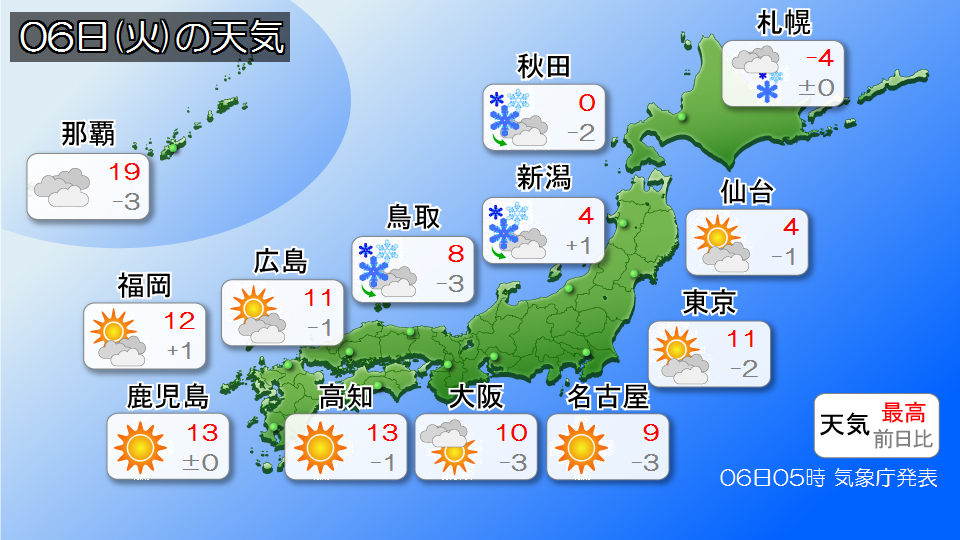
From the Sea of Japan side of Hokkaido to the Hokuriku region, the weather is likely to be prone to snow and rain. There are some places where the rain will be stronger and may be accompanied by thunder for a while, especially in the morning, so please be careful of lightning strikes, gusts of wind, and increased snowfall.
Also, strong winds will continue in the coastal areas, so it is likely that there will be snowstorms in some places. You also need to be careful about poor visibility due to snowstorms.
It will gradually stop in many places late at night.
The weather in northern Kinki and the Sanin area will require rain gear in the morning, but it is expected to stop in the afternoon in many places.
On the other hand, there will be many sunny areas in Kyushu and the Pacific side of eastern and western Japan. The temperature in each region will drop from the day before, so please be sure to protect yourself from the cold. The air will continue to dry, so please be careful when handling fire.
-
3-day holiday Winter storm on the Sea of Japan side Winter-type atmospheric pressure pattern will continue until Coming of Age Day It will continue to be cold like the cold from now on [Weekly weather forecast]
2026/01/05 12:42
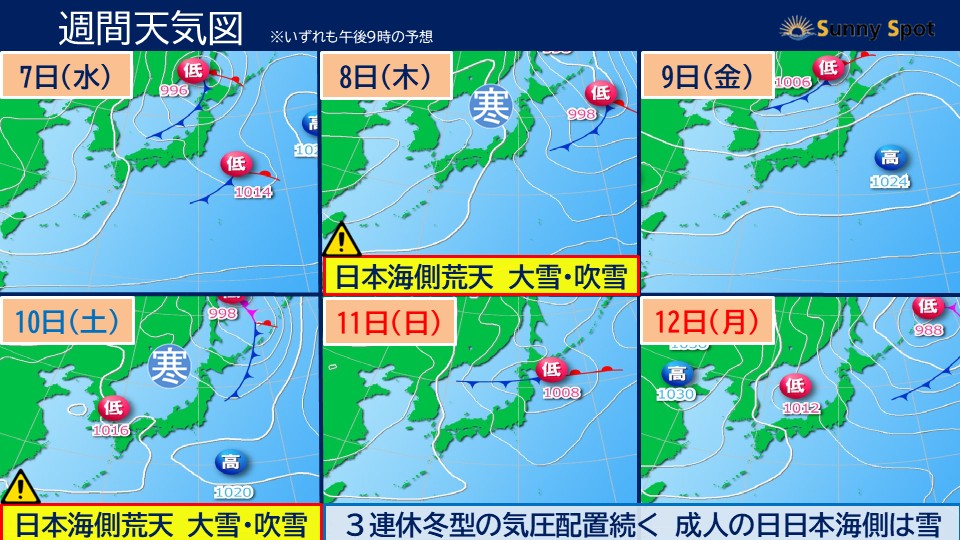
-
Weekly Weather Forecast
#Winter-type atmospheric pressure pattern is often strengthened
#3-day holiday Winter storm on the Japan Sea side Winter-type pressure pattern will continue until Coming of Age Day
#Cold weather continues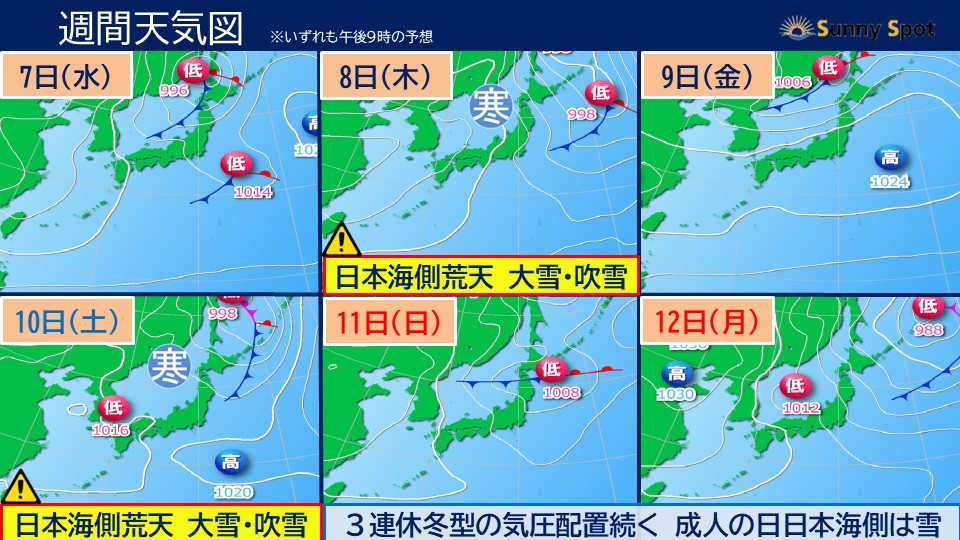
#Winter-like atmospheric pressure patterns are becoming stronger
From today, the 5th (Monday), we will be experiencing the ``Shokan'' of the 24 solar terms.
This is the time when the cold weather becomes severe, and the period of cold weather and cold weather leading up to Setsubun is called ``Kan no Uchi.''
The first day of Kokan is also called ``Kan-no-iri''.
For the next week, it is expected to be cold, with winter-like pressure patterns becoming more frequent, and cold air expected to flow in with increasing strength.
Tomorrow, the 6th (Tuesday), in the afternoon, the winter-like atmospheric pressure pattern will loosen from the west, and the area of snow and rain on the Sea of Japan side will become narrower.
A low-pressure system will form in the central part of the Japan Sea at night, and is expected to rapidly develop and move toward the northern part of the Japan Sea the next day (Wednesday), the 7th.
The front extending from the low pressure system will pass near northern Japan, so there will be rain and snow in Hokuriku and snow in northern Japan.
On the 8th (Thursday), a low pressure system is expected to develop as it moves towards the Sea of Okhotsk, and the front will pass near northern Japan, resulting in winter-like pressure patterns near Japan once again.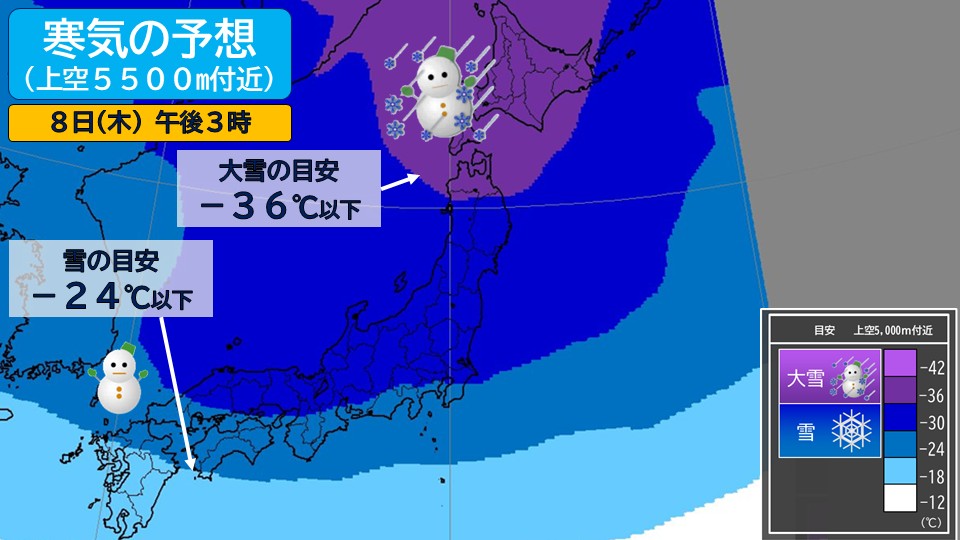
The winter-like pressure pattern will become stronger, and as strong cold air flows into the upper atmosphere, the area where snow will fall will expand on the Sea of Japan side.
Rain and snow are expected in northern Kyushu, and snow is expected to fall in the Chugoku-Hokuriku Japan Sea side and northern Japan.
To the east and north of Japan, the Sea of Japan side will experience rough weather with strong winds, rising waves, and blowing snow.
Although the winter-like pressure pattern will temporarily loosen on the 9th (Friday), the winter-like pressure pattern will strengthen again over the three-day weekend, making it likely to become a winter storm.
#3-day holiday winter storm on the Sea of Japan side Winter-type atmospheric pressure pattern will continue until Coming of Age Day
On Saturday, the 10th, the first day of the 3-day holiday, a low pressure system is expected to develop as it passes near northern Japan and heads toward the Sea of Okhotsk.
Winter-like air pressure will become stronger near Japan, where strong cold air will flow into the upper atmosphere as it moves westward.
It is expected that rain and snow will fall from the San'in area to the Sea of Japan side of Hokuriku, and there will be places where wet snow will fall along the mountains in the northern part of Gifu, Nagano, and Gunma prefectures.
It will snow intermittently in northern Japan.
The weather is expected to be rough in eastern and northern Japan on the Sea of Japan side.
On the Sea of Japan side of Hokkaido, there is a risk of a warning-level blizzard, which could turn into a blizzard and become a winter storm.
After that, the winter-like atmospheric pressure pattern will continue around Japan until the 12th (Monday), Coming of Age Day, the last day of the three-day holiday.
Please be aware of the latest information as transportation may be affected during the three-day holiday period.
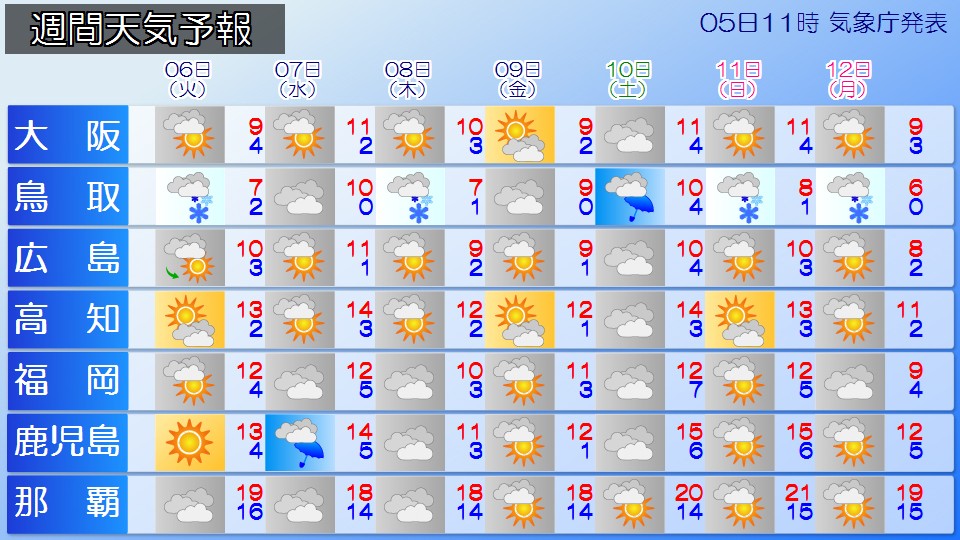
#The midwinter cold continues
As cold air repeatedly flows into Japan, the midwinter cold is expected to continue.
Please take care of your health.
-
Heavy snow and blizzard on the Sea of ??Japan side, dry weather on the Pacific Ocean side, and be careful when handling fire.
2026/01/05 09:54
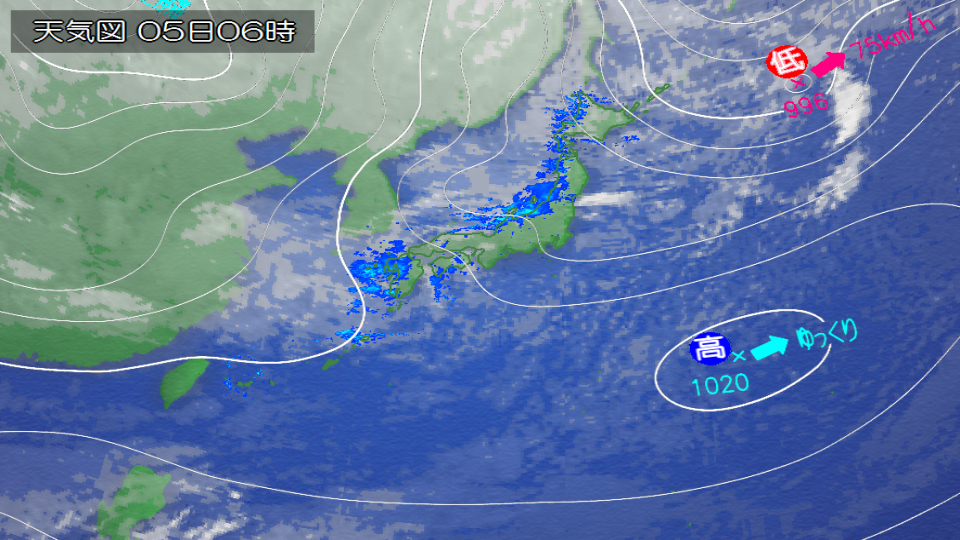
-
There is a developed low pressure system east of Kamchatka that is moving northeast.
There is also a low pressure system east of the Kuril Islands that is moving east.
On the other hand, high pressure is extending eastward from the continent, creating a winter-like atmospheric pressure pattern around Japan.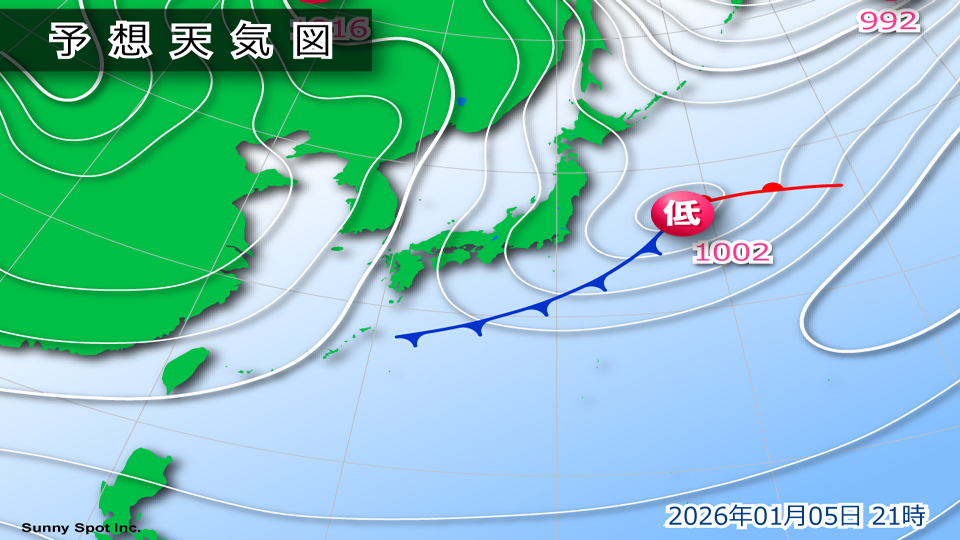
Currently, it is snowing and raining from Hokkaido to Hokuriku, and raining and snowing in Kyushu and Shikoku.
Today, the 5th (Monday), the winter-like pressure pattern is expected to intensify, and we will be affected by a trough of pressure accompanied by cold air of -30 degrees Celsius or less at an altitude of approximately 5,500 meters.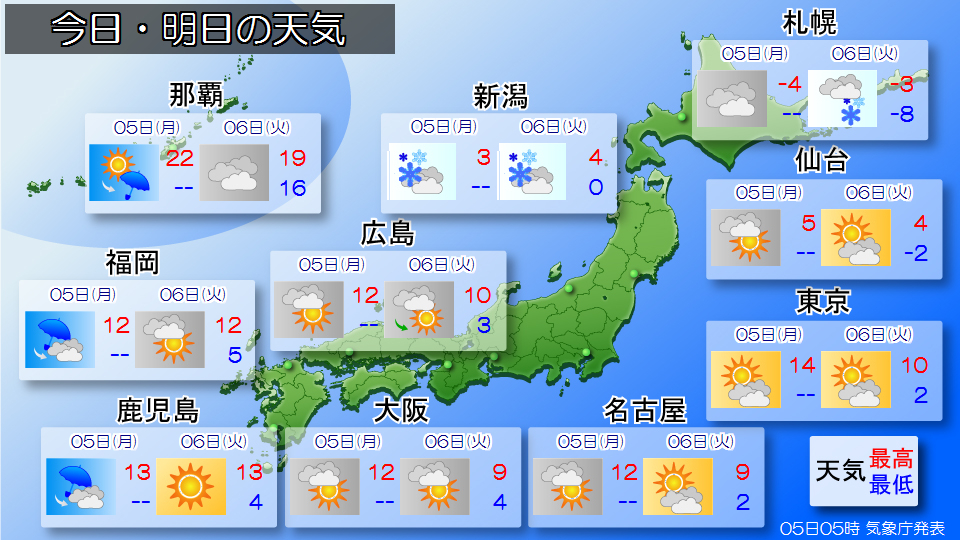
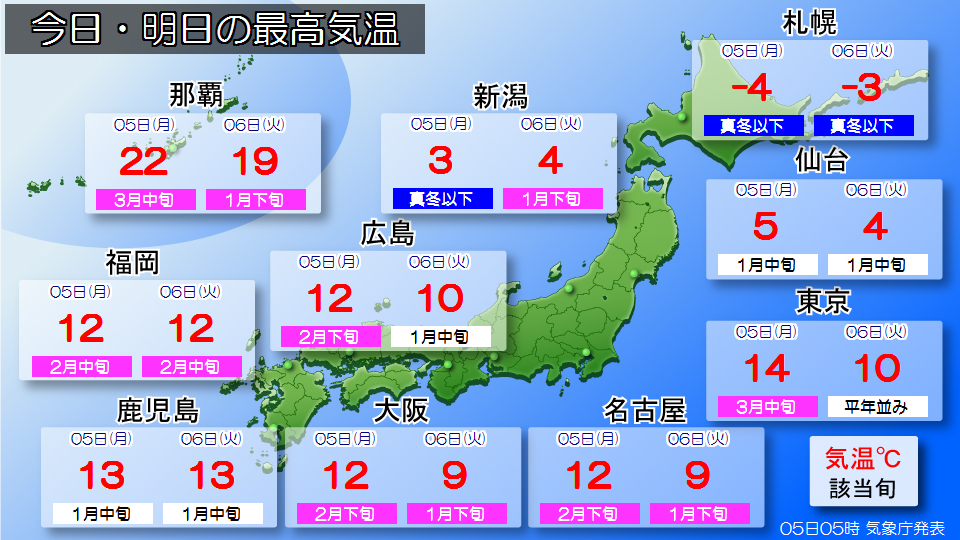
From Hokkaido to Hokuriku, there are many places on the Sea of Japan side where it snows and rains.
Please be aware that the atmospheric conditions in Tohoku and Hokuriku may become extremely unstable, leading to heavy snowfall accompanied by thunder.
Also, rain and snow are expected to fall in some places from the Kinki region to the Okinawa region due to the cold and humid air.
Although there are some places on the Pacific side of northern and eastern Japan, it will be sunny, but the air will remain dry. Please be careful when handling fire.
-
JPCZ will appear starting tonight. Start of work. What's the weather like this week [Weekly weather]
2026/01/04 11:54
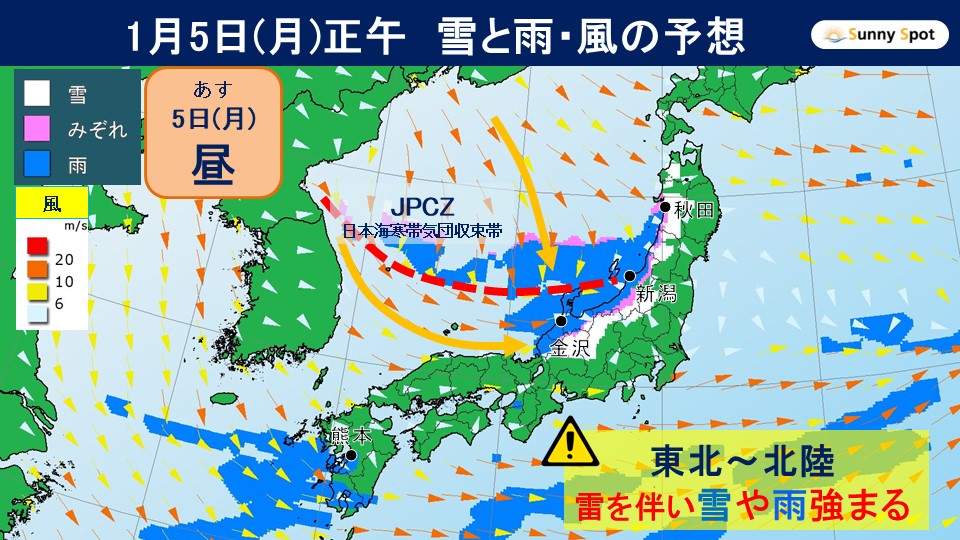
-
#Weather points for the next week#
5th (Monday) to 6th (Tuesday) JPCZ appears, heavy snow in Hokuriku and Tohoku
8th (Thursday) Low pressure develops, stormy weather is possible in northern and eastern Japan
10th (Sat) West time Intense cold air is flowing in, with the possibility of snow on the Pacific side
I'm sure many of you will be starting work tomorrow, January 5th (Monday), but let's take a closer look at the weather for the week after the New Year.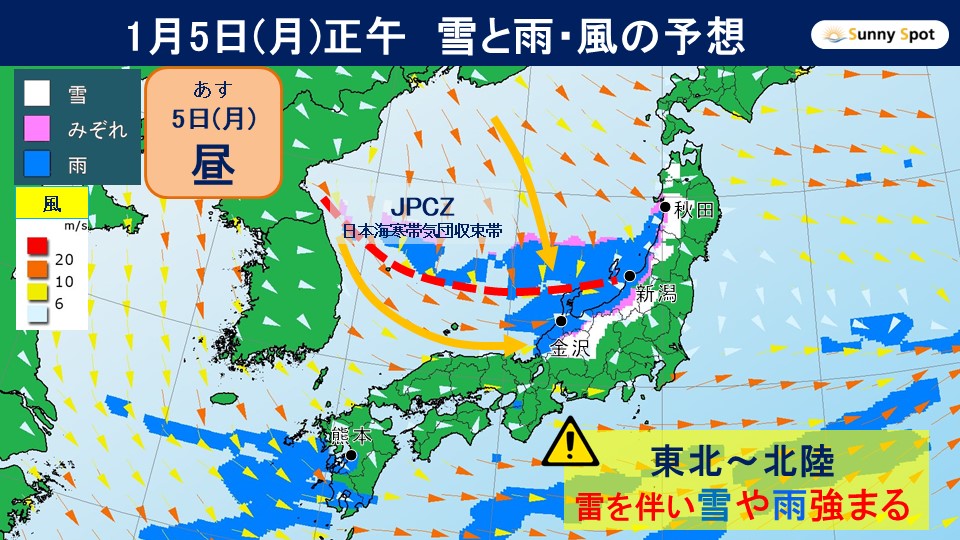
#Tomorrow 5th (Monday)#
From tonight to tomorrow 5th (Monday),
JPCZ (Japan Sea Polar Air Mass Convergence Zone) is expected to form in the Sea of Japan,
toward Tohoku and Hokuriku regions.
This JPCZ is a convergence zone created when
cold air currents (northern winds) are divided into two by a high mountain in the northern part of the Korean Peninsula,
and then merge again over the Sea of Japan.
Looking at the forecast for snow, rain, and wind at noon on the 5th (Monday) tomorrow,
the winds are colliding (converging) and forming band-shaped rain clouds over the Sea of Japan.
An active precipitation band will occur near this convergence zone, and
there is a possibility of increased snowfall along the mountains where this precipitation area falls.
Especially tomorrow, the 5th (Monday), there will be a lot of people moving around for work, but heavy snow and rain may affect
transportation in the Tohoku and Hokuriku areas.
Let's act with plenty of time.
In addition, small cyclones and disturbances occur over the JPCZ,
cumulonimbus clouds may develop, causing hail, lightning, and gusts of wind.
You must pay close attention to changes in the weather.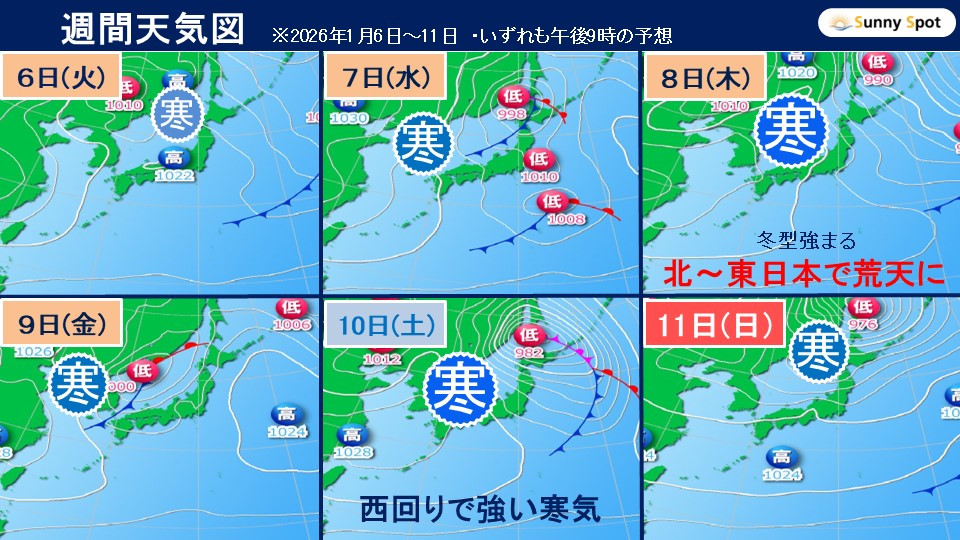
#6th (Tuesday)#
The vicinity of Honshu will gradually be covered by a mobile high pressure system, but
the sky over northern Japan will be covered by cold air.
Snow and rain will continue on the Japan Sea side, and there is a possibility of
warning-level heavy snow around Yamagata Prefecture.
On the other hand, it looks like there will be many places on the Pacific side where it will be mild and sunny.
#7th (Wednesday)#
A low pressure system accompanied by a front will pass near Japan, and
low pressure is also expected to form near the Kanto region.
Up until yesterday, the forecast was that there was a possibility of snow falling again in the Kanto region due to the strong influence of the low pressure near the Kanto region,
but the latest forecast shows that the area covered by snow clouds and rain clouds has narrowed, and the possibility of snow and rain falling in central Tokyo has decreased.
However, the trend and development of the low pressure system, as well as the forecast for cold air above
, may still change, so please continue to pay close attention to the latest information.
#8th (Thursday)#
A low pressure system will develop near the Sea of Okhotsk, and
a winter-like pressure pattern will become stronger near Japan.
There will be rough weather mainly on the Sea of Japan side of northern and eastern Japan, and depending on the degree of strengthening of the winter-type atmospheric pressure distribution, there is a risk of severe stormy weather.
There is a possibility of warning-level storms on the Sea of Japan side of northern Japan and Hokuriku, so please be careful about the impact on transportation.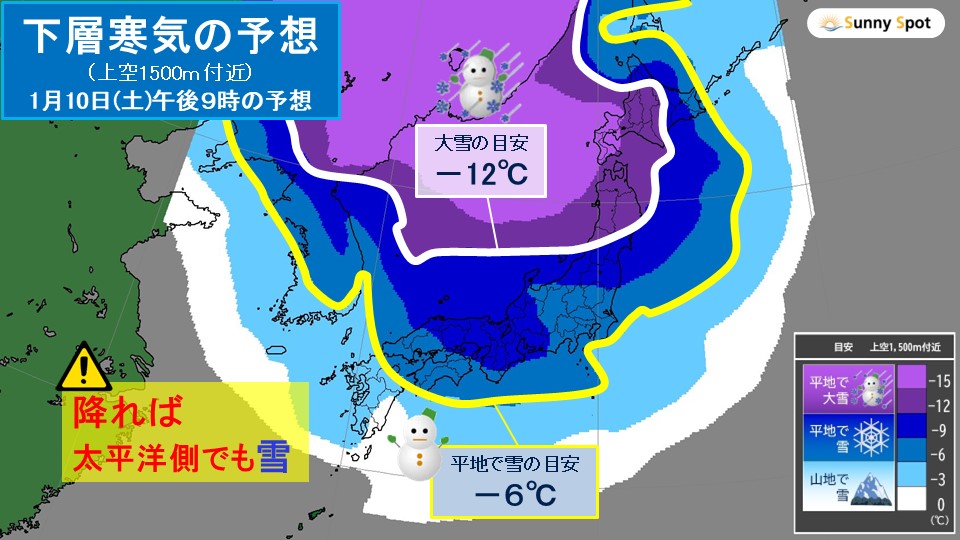
#9th (Friday) to 11th (Sunday)#
A new low pressure system has formed in the Sea of Japan, and is expected to continue to develop from
10th (Saturday) to 11th (Sunday) as it moves toward the Sakhalin area.
Especially around the 10th (Saturday), the winter-like pressure pattern will become stronger, and
strong cold air will flow in westward.
Snow is falling on the Pacific side of western and eastern Japan, and it seems that there will be some places where it will accumulate again on the flatlands.
During the first week of work, the weather has been changing rapidly,
the cold has become stronger and weaker, and
the temperature and sensation seem to change drastically from day to day.
Please check the latest weather frequently and take care of your health.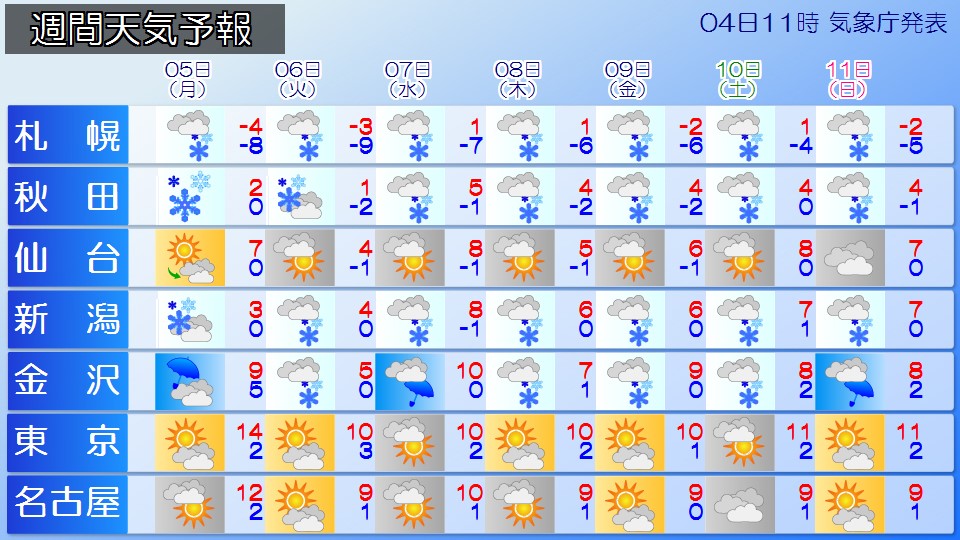
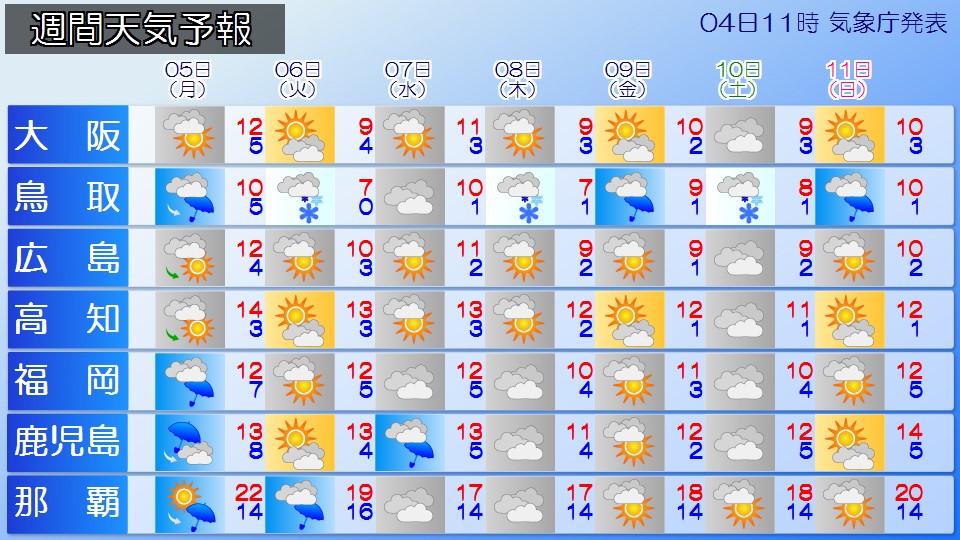
-
Weather for the week: Winter-like atmospheric pressure patterns continue; watch out for stormy weather in the second half of the week, especially on the Sea of Japan side
2026/01/04 09:11

-
From now on, there is a possibility that winter-like pressure patterns will become stronger and the weather will become stormy due to the influence of a developing low pressure system.
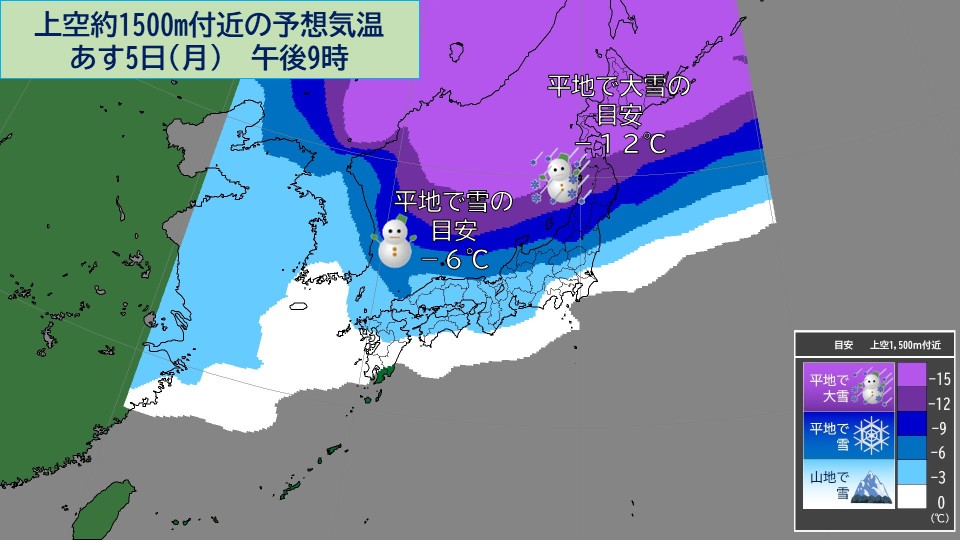
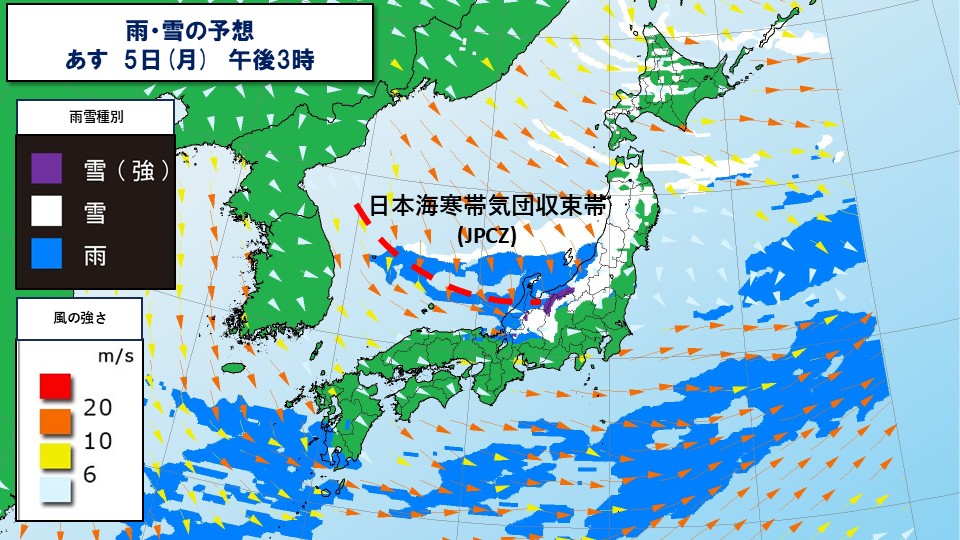
Tomorrow, the 5th (Monday), strong cold air in the upper atmosphere will move southward near Honshu through the night, strengthening the winter-like pressure pattern. Over the Sea of Japan, snow clouds that have developed due to the Japan Sea Polar Air Mass Convergence Zone (JPCZ) are expected to gradually move southward from near Hokuriku to the shadow of the mountains.
There will be snow from the Sea of Japan side of northern Japan to Hokuriku and the Sanin area, and there will be places where the snowfall will be heavier.
In western Japan, from Kinki to Kyushu, there will likely be periods of temporary rain due to the influence of a trough in atmospheric pressure.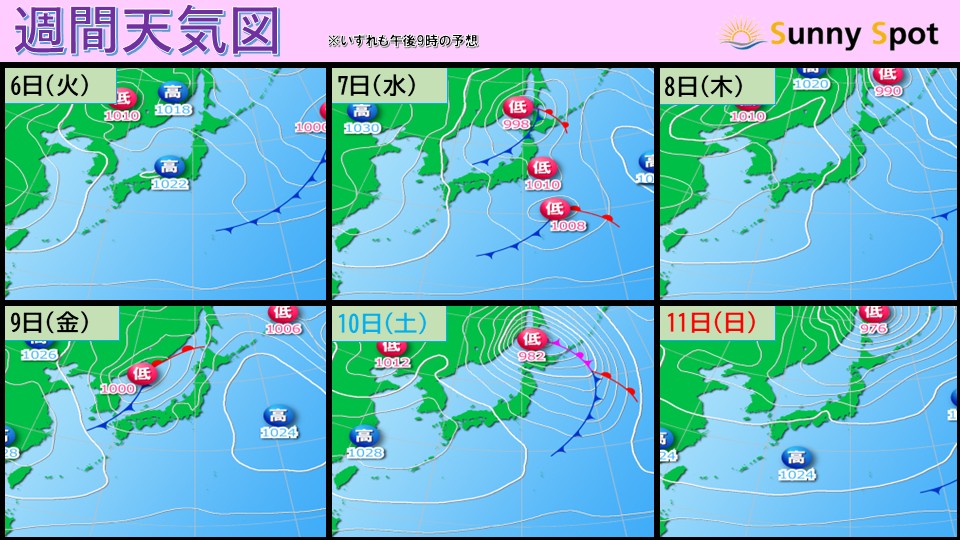
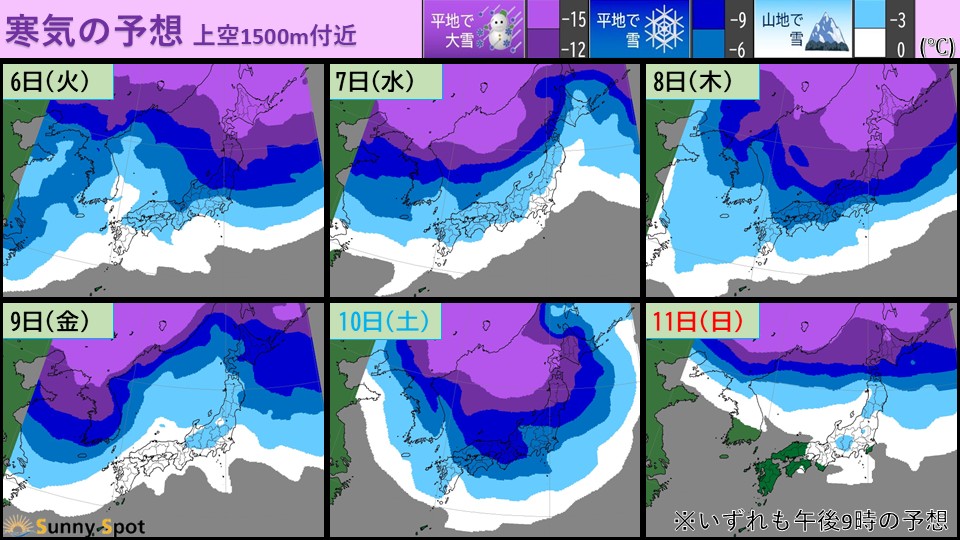
After the 6th (Tuesday), a low pressure system is expected to pass near Japan in short cycles, and strong cold air is expected to repeatedly move south and north around Honshu. After the low-pressure system passes, the strong cold air will move south and the winter-like pressure pattern will become stronger, leading to stronger snow and winds mainly on the Sea of Japan side.
Around the 7th, another low pressure system will form on the Pacific side, and there will be temporary rain in some places. After the low-pressure system passes, strong cold air will move southward, and the winter-like pressure pattern is expected to strengthen on the 8th.Therefore, there will be places where the snowfall will be heavier, mainly on the Sea of Japan side, and winds will also become stronger, causing blizzards in some places.
A new low pressure system is expected to pass near the Sea of Japan around the 9th to 10th, and continue to develop over the 10th before passing near Sakhalin. As a result, there is a risk of rough weather mainly on the Sea of Japan side.
As for the prediction of low pressure, there is a wide range of forecasts at the moment, but please pay attention to the latest weather information that will be updated in the future.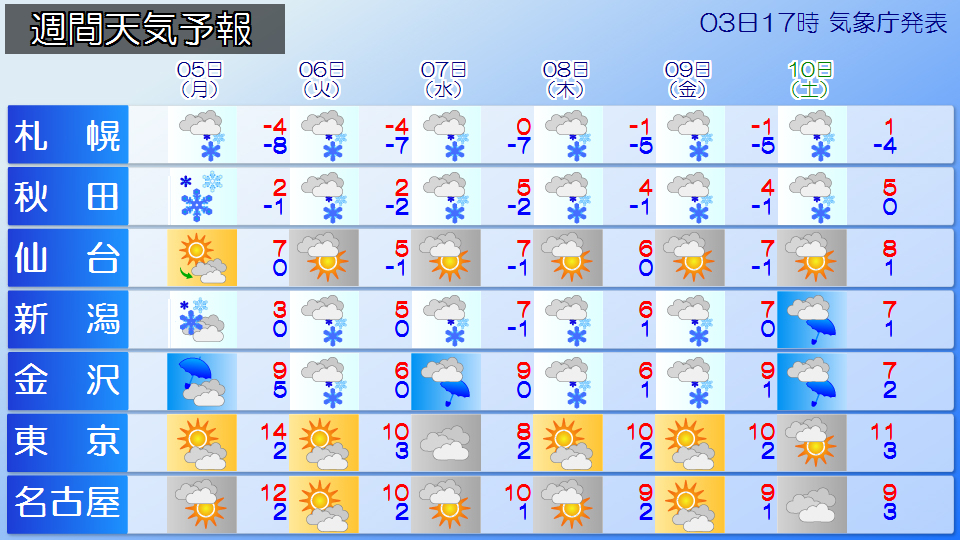
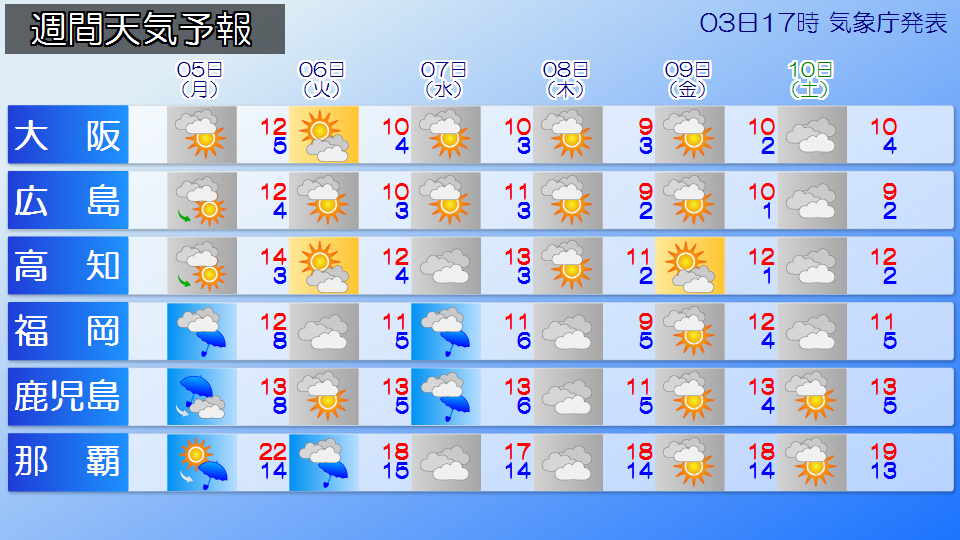
-
Weather on the last day of the New Year holiday: Snow and rain continues from the Sea of Japan side of northern Japan to Hokuriku
2026/01/04 07:14
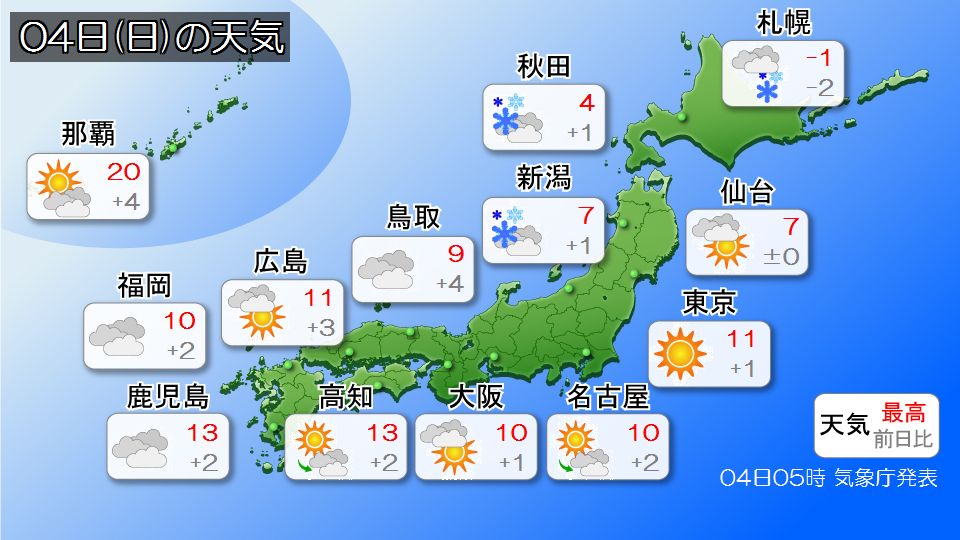
-
Today, the 4th (Sunday), the last day of the New Year's holiday, the air pressure around Honshu will be high in the west and low in the east, centered on northern Japan.
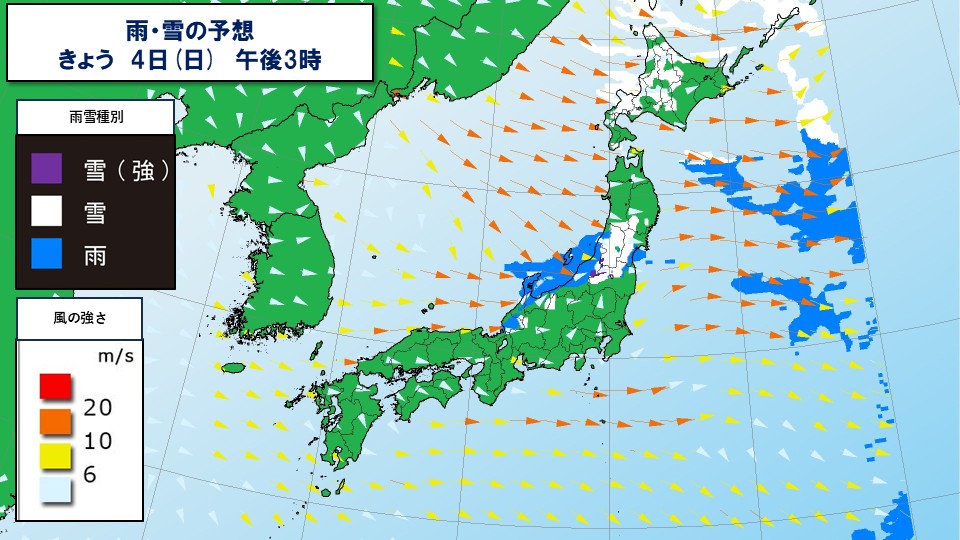
Snow and rain will continue from the Sea of Japan side of northern Japan to Hokuriku. In northern Japan, the isobars are closely spaced and strong winds blow from the west, so it is likely that there will be localized snowstorms. Please be careful of worsening visibility.
Hokkaido is expected to be extremely cold, with many places in the middle of winter with daytime maximum temperatures below 0c. It is essential to take proper measures against the cold.
In Hokuriku, there will be snow mainly along the mountains. In the plains, it is likely to rain for a longer period of time. There is a possibility that the rain will become stronger with localized thunderstorms, and the snow will continue to melt in areas where it rains. Please be careful of deteriorating road conditions, snow falling from roofs, and avalanches.
From eastern Japan to western Japan, there are many sunny places on the Pacific side. The daytime temperature is likely to be slightly higher than yesterday, the 3rd (Saturday), but it will be colder than usual for this time of year. The air tends to be dry, so please wash your hands and gargle frequently to stay in good health.







